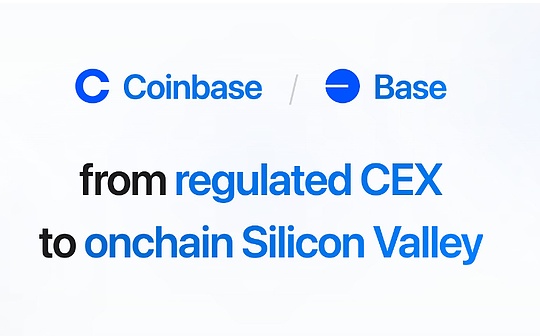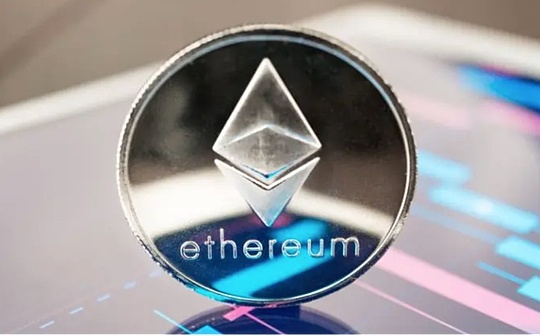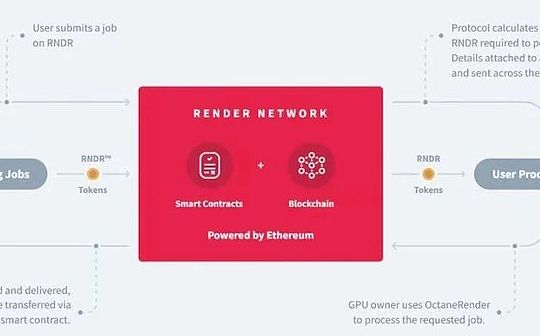
Render Introduction
-
Render Network is a decentralized rendering platform. It connects people with GPU computing power to provider with excess computing power, mainly for artificial intelligence, virtual reality, and media and content creation.It was officially launched in April 2020.
-
Render Network’s pricing model is dynamic and competitive, and it will take into account the complexity, urgency and available resources of the work.
-
Render Network allocate workloads between available GPU providers through the point -to -point network of the RNDR token to encourage nodes to provide extra computing power.
-
In December 2023, Render completed the migration from Ethereum to Solana, bringing new capabilities, such as real -time flow and dynamic NFT, and state compression.
Introduction to Depin concept
DEPIN (Decentralized Physical Infrastic Networks), decentralized physical infrastructure.MESSARI’s research report divides DEPIN into two main areas: digital resource network and physical resource network.Digital resource networks include storage, computing, and bandwidth, and the physical resource network focuses on hardware -related fields, such as wireless networks, geographical space networks, mobile networks, and energy networks.
Popw (Proof of Physical Work), physical workload certificate.Stimulate individuals to conduct verifying work, thereby promoting the development and efficient use of real world infrastructure.
According to the definition of “decentralized physical infrastructure”, almost all distributed networks can be classified as DEPIN:
Filecoin, arweave: decentralized hard disk
Ethereum: decentralized computer
Bitcoin: decentralized ledger
>
Figure 1 DEPIN track Mapping-1
>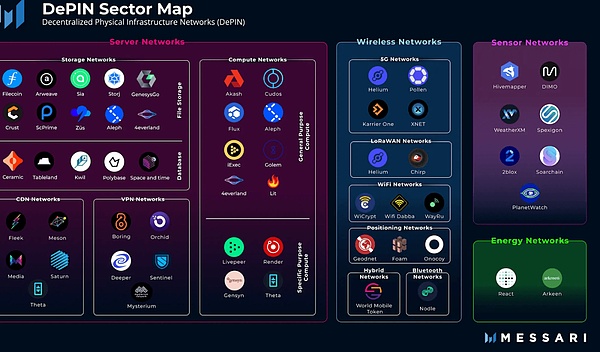
Figure 2 DEPIN track Mapping-2
Based on homogeneity, the concept can be subdivided again:
Deren “decentralized resource network” VSDEPIN “decentralized infrastructure network”
DEPIN: Web models with geographical location as key elements, deploying specific hardware equipment with geographical location through the incentive mechanism, thereby generating non -homogeneous resources.How to understand non -alternative?You can see the deployed mobile phone base station (China Tower) in all parts of the city.But the same base station, A base stands in Tsim Sha Tsui, B base is located in Shatian, but due to the different geographical location, they cannot replace each other.In this sense, each base station is unique and uniquely homogeneous resource.
DEREN: A resource -based network with weak geographical dependence, which establishes the market through an incentive mechanism and adds existing or idle alternative resources.These resources are generated by hardware that has nothing to do with geographical location.In the field of cloud service, DERENS is similar to cloud facilities, namely service (IaaS).For example, using AVWARE storage, user experience usually has weak correlation with the geographical location where the user is located, and the homogeneity of services is high.
>
>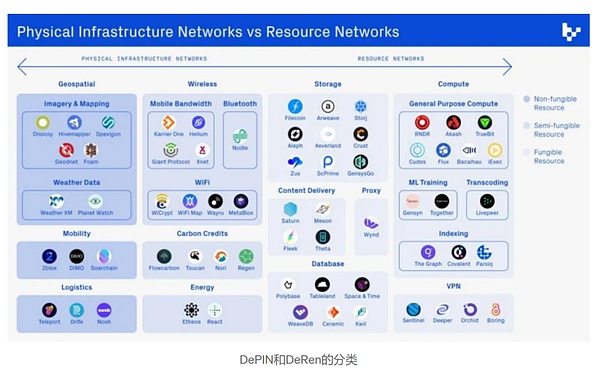
DEPIN industry research
The current situation of traditional ICT industry
The current ICT industry is facing the following two obvious dilemma:
1. High entry thresholds, insufficient competition, and monopoly by giants
The cluster of building data storage and cloud computing needs to invest a lot of funds for hardware purchase, venue leasing and personnel employment. Such a high cost makes almost only giant companies be able to join the industry.For example, AWS, Microsoft Azure, Google Cloud, Alibaba Cloud’s common market share in the fields of cloud computing and data storage are close to 70%.This leads to a high cost.
>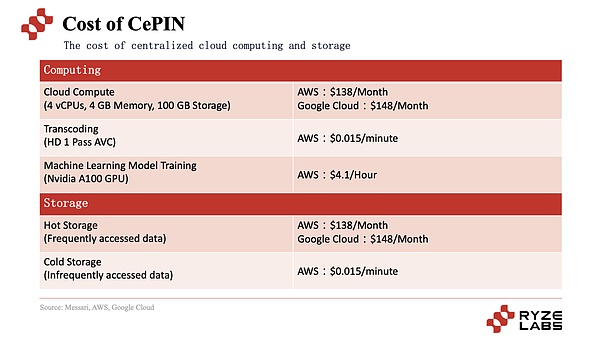
2. The resource utilization rate of centralized infrastructure is low
The low utilization rate of centralized infrastructure resources is a major challenge in today’s business operations.This problem is particularly prominent in the cloud computing environment, and the company usually distributes a large number of budgets for cloud services.According to the recent report of Flexra (2022), a worrying trend has appeared. On average, 32 % of the company’s cloud budget was wasted.This has caused huge financial losses.
Depin’s advantage
1. The model from capital -intensive industries to P2P/P2B
Reduce the threshold of enterprises, break the price monopoly, and have more economical choices for users
2. Reuse idle resources to improve the efficiency of resource utilization
In traditional economic models, many resources are idle and failed to exert its potential value.Many users hold many idle resources, whether it is storage, computing power, or data, the key is how to mobilize these resources.Through the incentive mechanism, DEPIN encourages users to share and use their resources to maximize the utilization rate of resources.
Taking cloud as an example, according to Flexra reports, the effective utilization rate of enterprises purchased clouds in 2022 was only 68%, which means that 32%of cloud resources were wasted.Considering that Gartner is expected to reach nearly 500 billion US dollars in 2022, which means that roughly estimated that the $ 160 billion cloud expenditure will be wasted.And this waste of resources can be used through DEPIN.
3. Eliminate middlemen, more efficient money flow
Among the traditional Meituan, Public Comment, Didi and other O2O projects, the platform charges high intermediary fees, which is equivalent to a tax wedge (Tax Wedge), and social efficiency has not reached the best state.Many items have been trying to solve this problem on the Depin track, such as Drife applications, takeaway applications DEVOURGO, Public Comment Application Ketchup Republic, etc.
>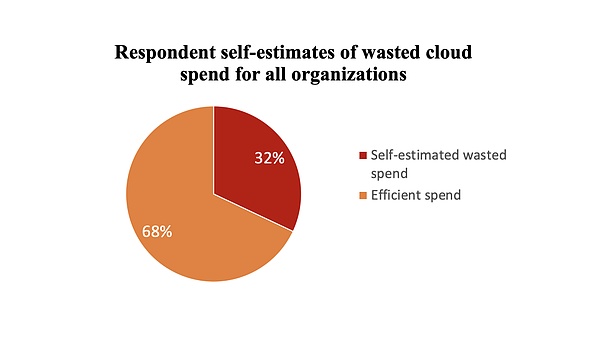
The relationship with solana
The DEPIN protocol often requires real -time response and lower transaction costs.Many protocols now tend to use existing ecosystems instead of establishing their own chains.At present, many DEPIN leading agreements have been relocated to Solana.
Solana is very suitable for DEPIN / POPW with its high -speed blockchain and the characteristics such as 0.5 seconds, and direct processing verification.In addition, Solana’s CNFT provides more cost -effective licenses for DEPIN / POPW nodes, which is a common practice.
More and more DEPIN / POPW protocols choose Solana as their basic layer.Almost all segments of the DEPIN / POPW protocol have been successfully integrated with Solana, providing proof for the initial concept of doubt about these protocols.
DEPIN market size
Judging from the current market value rankings in the field in the field, most of them belong to the fields of Storage and Computing.(Ryze Labs, October 2023)
>
Render detailed explanation
1. Introduction to the project party
Render Network was founded by OTOY. OTOY is a company focusing on 3D rendering technology. It is also the first founder in the world to make full use of GPU business rendune software.Cloud graphic company.The idea of rendering the network was born in 2017. At that time, OTOY released a white paper with an overview network technology details.
Through the Octane Render’s subscription account, you can directly access the RENDER.(Also the only way to use Render Network’s computing power)
All tasks that can be rendered by Octane Render can be rendered on Render Network, including movies, animation, games, virtual reality scenes, and so on.
2. Tokens Economics model
The architecture of Render Network
In the current state, Render Network consists of two main layers:
1. Demin rendering network, including creators, node operators, rendering networks, and rendering application layers.Node operators are GPU nodes that provide network power.
The blockchain layer is processed through Render and smart contracts.
2. Node operators and founders interact with each other in distributed network models that are arbitration of the core network infrastructure of the server.
Octanebench is a proper benchmark testing tool (also the most popular GPU rendering base test) today, which is used to measure the GPU rendering speed represented by the number of Octanebench points (OBH) per hour, thereby determining the pricing of the rendering task.Octanebench is used for standardization and benchmark testing GPU performance to ensure that creators are consistently priced at the request node operator.The cost of any task is based on Octanebench and is determined by the multi -layer pricing (MTP) algorithm.
RENDER token
-
RNDR acts as a practical tokens on demand GPU rendering services.The creator paid the rendering working fee through RNDR.They can access various GPU providers with different speeds, security and price levels.At present, the pricing is divided into three layers: the first layer (the trusted partners), the 2nd floor (priority) and the 3rd layer (economy).Tier 2 and Tier 3 are available, Tier 1 will be launched in the future.
-
Secondly, a reward mechanism for GPU providers.Node operators can use idle GPU capabilities to rendering operations on the rendering network and earn RNDR tokens as returns.The number of tokens they earn depends on the level, duration and complexity of rendering operations.Node operators can also pledge their RNDR tokens to improve their reputation and gain more rendering work.
-
Third, RNDR is the governance tokens of the agreement, allowing token holders to affect the governance of the rendering network.
Token distribution:
-
40%for development
-
25%for growth
-
20%for operation
-
10% for reserves
-
5% for creation of the world
>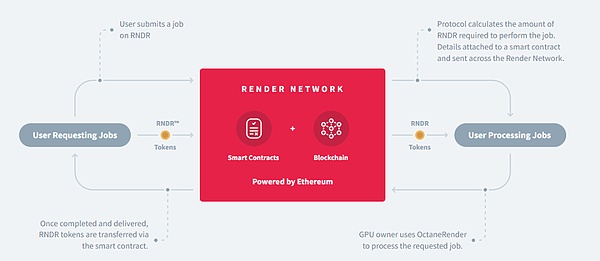
Token economics model
Dynamic pricing model
The dynamic pricing mechanism of rendering networks ensures that competitive service costs are provided for content creators and provided fair compensation for GPU providers.The pricing model takes into account factors such as work complexity, urgency and resource usability to determine the best cost to provide services.Its dynamic methods do not rely on static or manual pricing systems, but to meet the needs of user groups and ecosystems.
The price of render network rendering service
>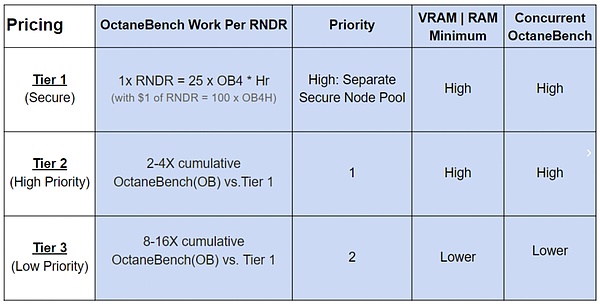
3. Match algorithm
Use the matching algorithm to connect the content founder to the appropriate GPU provider.By evaluating factors such as GPU types, capacity, location, and provider reputation, RENDER Network can ensure that the rendering operations are effectively allocated across resources, thereby maximizing the efficiency, speed, and cost benefits of rendering services.
The reputation score of the task founder and node operator
The reputation of node operators is established by timely and accurately.
The creator establishes a reputation score by successfully using the network.As the creators accumulate a series of successful work records and minimize user errors, they can access more concurrent GPU nodes.
Reputation scores help the network effectively allocate and reduce unintentional congestion caused by failure rendering or malicious Sybil attack.The reputation scoring system is regularly updated to increase network efficiency because work complexity and network services are continuously evolved.
Priority of task allocation
The reputation score of the founder affects its task allocation priority through two ways:
1. Mission creators with high reputation scores can run more concurrent tasks on the Internet.
2. According to the current reputation score of the creator, add priority modifications to each job, so that the task of creators with high reputation scores is more attractive than the same task of low reputation score creators.
Priority of node distribution
Node allocation is the process of allocating the rendering of each task for nodes.
When the task is sent to the rendering network, they will be assigned to node operators according to factors such as layers, hardware requirements, network time, user reputation, node reputation scores, and Octanebench scores.
4. Privacy and security
When rendering or processing any creative or confidential materials, privacy and security are essential.In order to protect the privacy of the creators and assets in the network, the combination of system use to end -to -end encryption, hash, virtualization, and security concentrated storage:
Each scene is decomposed into many separate assets, and hash and encryption when uploading to the Internet.
The rendering output will be encrypted before sending through the network.Any asset stored in memory or disk is always encrypted.
Each frame is added before downloading to ensure that the payment has been completed before downloading.
5. ORBX format (high compatibility)
Render Network uses open ORBX file formats and streaming media frameworks to support complete distributed rendering.ORBX is a container format that is used to capture the XML rendering of scene data (assets) and describes the semantic of the scene.Just like web pages, it can be cached to the archive file (.orbx file), or through the original UDP/TCP or Web WSS or HTTPS from URL or URI, it is transmitted.ORBX format supports more than 20 industry -leading DCC (digital content creation) tools, and includes industry standard sub -formats, such as Alembic, OpenVDB, EXR, Open Shader Language (OSSL) and GLTF.ORBX exports more and more by natively integrated into the Octane RENDER interface, realizing a third -party plug -in host of a simplified one -click export process to Render Network, and improving the export speed and compatibility with the effect of expanding the third -party plug -in and library.Essence
Reference information
Research report
1. Is the two -way rush to DEPINA and DEPIN, will it bring DEPIN summer?
https://mp.weixin.qq.com/s/se4woyst8- -jocjpydxw
2. Ryze Labs Words Research Report: Interpret the DEPIN track in all aspects.
https://mp.weixin.qq.com/s/sbwhxymtlwsbsvibibibhs1cua
3. Web3+Aiot = DEPIN, look at the future development of DEPIN in the WORLDCOIN project of OpenAI.
https://yakihhhhhne.com/article/naddr1qq2kwnmgg424jsm829vhjaee0khgs20Fuerqq3q08nx6y5gu3dz6urhhlCgTXCML2Hykrvj0r6qnrqnRQ xpqqqp65wzs548Q
4. DEPIN track potential project in -depth interpretation.
https://mirroor.xyz/0x30bf18409211FB048B8ABF44C27052CF329F2/kaqz7kadjyhi8zh_a81LM4- ZSLDHQK90909090
5. One article excavate the DEPIN track investment opportunity | Trendx Research Institute. B4ooqg
6.
https://iotex.io/blog/depin- landscape-d/
7. What will happen to ZKML+DEPIN?
https://mirror.xyz/0x867a3f354c0ECB662AEF1BF14C3BE79338AD889/c6h_usctsef31hkawntxl4_etQQQL0_xg7rfee
8.
https://coinmar documentcap.com/academy/article/a-dive-nTO-DEPIN-DECENTRIZED-PHYSICALASTRUCTURE
9.https://coinmarketcap.com/academy/article/what-ender-Network-dr
10.https://globalCoinresearch.com/2023/04/26/Render-sCaling-rendering-for-the-expression/
11.https://www.coinfeeds.io/research/an-nTroduction-to-the-Render-network
12.https://foreSightnews.pro/article/detail/40042
Project link
1. Filecoin https://filecoin.io/zh-cn/
2. Arweave https://www.arweave.org/
3. Helium https://www.helium.com/
4. Render https://rendernetwork.com/
5. livepeer https://livepeer.org/zh
6. Space and time
https://www.spaceandtime.io/
7. emc https://edgeMatrix.com/en/
8. PowerPod https://www.powerPod.pro/
9.kandola https://kandola.network/index.html#home






